All Articles & Guides / Cremation / A Guide to All Types of Green Burials and Cremations
A Guide to All Types of Green Burials and Cremations

Green burials, or eco burials, are growing in popularity across North America, and for good reason. This type of burial is significantly more eco-friendly, natural, and devoid of toxic chemicals. Although cremation is a more eco-conscious approach, there are other ways to have an even smaller environmental footprint. Here are some key things you need to know about eco burial alternatives.
What Is a Green Burial?
A green burial involves laying to rest a loved one in a way that reduces the environmental impact of a traditional funeral ceremony. The green funeral method is focused primarily on the conservation of natural resources and the use of environmentally friendly components in the ceremonial materials, including the casket, shrouds, and urns.
How Much do Green Burials Cost?
Green burials can be substantially cheaper since they don’t include embalming, ornate caskets, or extravagant extras such as mausoleums or vaults. Some funeral homes offer both regular and green burials in the same location.
Depending on what type of ceremony you want to have, the average price of a green burial can fall anywhere between $200-$4000. The natural burial cost varies based on whether you choose to bury the body or choose green cremation options, if you include a stone marker, and more. Of course, the specific green cemetery in which you decide to lay your loved one to rest will significantly influence the price as well.
Where Are Green Burials Allowed?
Now that you know what a green burial is, what are your options? Natural funeral sites are growing in popularity across North America. Green burial sites are also sometimes called “eco cemeteries,” so keep that in mind when searching for your ideal location. All provinces and territories in Canada allow for green burials. There are many funeral homes that will also help assist you with carrying out a green burial.
Most funeral sites only allow biodegradable materials, such as linen, bamboo, and wood, and embalming is usually not allowed. Natural markers are required as opposed to traditional ornate gravestones: you can mark your loved ones’ grave with a stone, and even a shrub or tree in some areas. The Green Burial Society of Canada is a good resource to learning more about this practice.
What Is a Conservation Burial?
A conservation burial ground is typically partnered with a conservation organization and has developed an approach that not only reduces environmental harm but also actively restores it. Conservation burial plots implement environmental restoration management plans that adhere to the principles of the scientific field of study, known as restoration ecology, in an agreement called a “conservation easement.”

Alternative Eco Burials
Since cremation doesn’t require the amount of land required for cemeteries or leave behind hundreds of thousands of gallons of formaldehyde in the ground each year, it’s viewed as an eco-friendly alternative to traditional burials.
One aspect of the cremation process that is arguably not “green” is that facilities release greenhouse gases and particulate matter into the atmosphere. New cremation furnaces have been developed to reduce emissions; however, they still burn natural gas which releases carbon dioxide and other by-product gases because of cremation.
An alternative form of green cremation that doesn’t require the use of cremation furnaces is water cremation, or alkaline hydrolysis.
What is Alkaline Hydrolysis?
Also referred to as bio cremation or aquamation, this technique uses water and potassium hydroxide heated to 350F to dissolve the body. The process takes between 2 and 3 hours and uses much less energy than regular cremation.
Alkaline hydrolysis is not a new form of cremation, but it didn’t receive much attention until the University of Florida began using it in the 1990s to dispose of donated research cadavers. Today only 20 states have legalized water cremation while 30 sit on the fence or oppose legalizing alkaline hydrolysis.
Alkaline Hydrolysis Cost
Currently, alkaline hydrolysis costs vary depending on the funeral home and state. As they become more popular costs may lower, but they typically cost the same or slightly more than traditional cremation.
The Environmental Impact of Conventional Burials
Green burials are significantly better for the environment and wildlife that may be present near a burial site. This is because the materials and practices used in a traditional funeral ceremony introduce toxins into the environment from the chemicals used in the treatment of the casket to the carbon emissions from the transport of the remains.
Commercially produced caskets take an excessive amount of time to break down in the soil. Not only that but the chemicals used to treat the casket, like paint and veneer, will leach into the soil and degrade the quality of the environment for surrounding vegetation. Also, because cemeteries are expansive lawns, there is a tremendous loss of natural habitat due to the amount of vegetation that must be cleared to construct these institutions.
How Natural Burials Can Make a Difference to the Environment
In green burials, caskets, urns, shrouds, and any other ceremonial materials or equipment are ensured to be sustainably sourced and won’t release pollutants and toxins into the environment.
The natural burial method is also highly concerned with the health of industry workers. The embalming fluid required to traditionally preserve a body is partially composed of formaldehyde which is a known carcinogen. Formaldehyde has been found to pose serious health risks to those who have frequent exposure to the chemical. With green burial body preparation, workers use formaldehyde-free alternatives that have been approved by the Green Burial Council to protect the health of the worker.
Are Natural Burials Legal?
Burial laws state natural burials are allowed in Canada.
There are five principles of a green burial according to the Green Burial Society of Canada:
- No embalming
- Communal memorialization
- Optimized land use
- Direct earth burial
- Ecological restoration and conservation

Tips on Determining Green Burial Policies in Your Area
If you are planning a natural burial, one of the first things you need to determine is where the ceremony will be taking place. Based on your own or your loved one’s personal values, will the ceremony be a green burial or a conservation burial? Will it take place at a green or conservation burial site? If not, will you be carrying out the ceremony at home? Will a cremation take place first and will the ashes be buried in a biodegradable urn?
All of these matters will factor into the specific laws you will need to research for your natural burial. State laws generally have authority over the requirements of embalming procedures and general areas where burials can take place (official cemetery vs. at home). You will need to look into local laws when deciding to do a home burial for further details. These will be available through city or county ordinances.
How to Begin Planning a Green Funeral
The process of planning a funeral, whether planning ahead for yourself or for a loved one, is difficult and highly emotional. Following a funeral planning checklist can help keep you organized and help you delegate work to others willing to help.
You must be sure of the province and city in which the burial is taking place due to the specific requirements and standards of a green burial. This will determine the process and materials you will need. Remember that the average cost of a green burial will vary widely according to location, so have your site planned out in advance to raise the necessary funds.
After all of this is set, you can choose what type of ceremony you would like, whether a burial or cremation is necessary, and then you can move on to specifics like grave markers and biodegradable urns. We hope the natural burial suggestions provided bring some ease and comfort to your time of need.
Related Content





